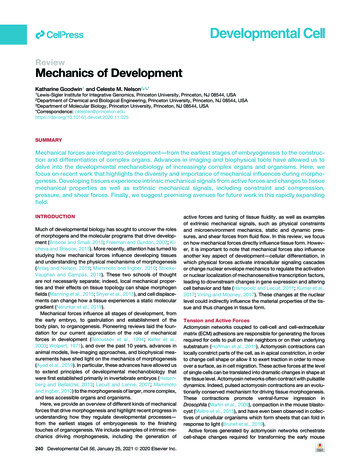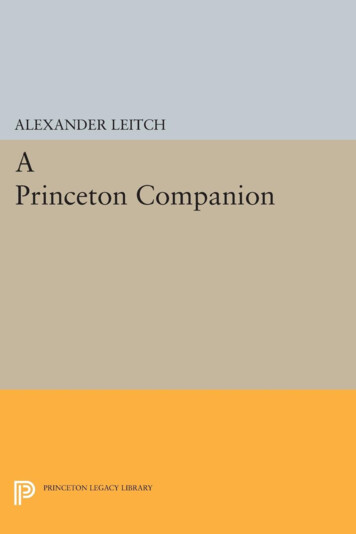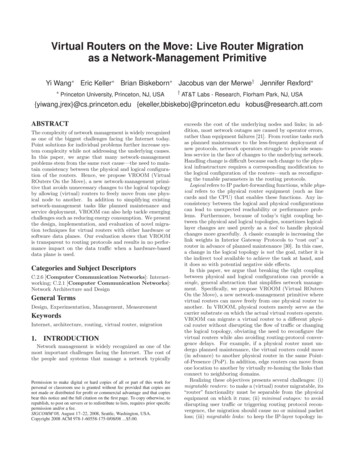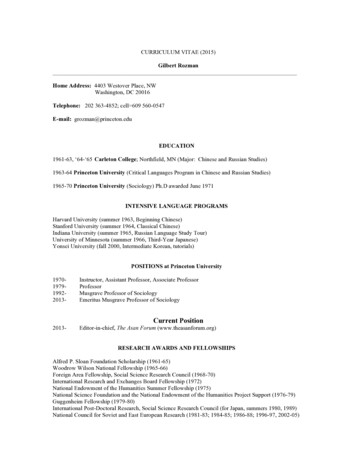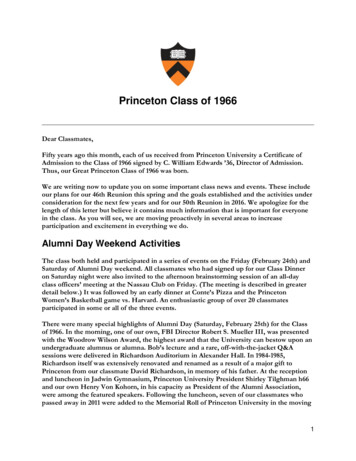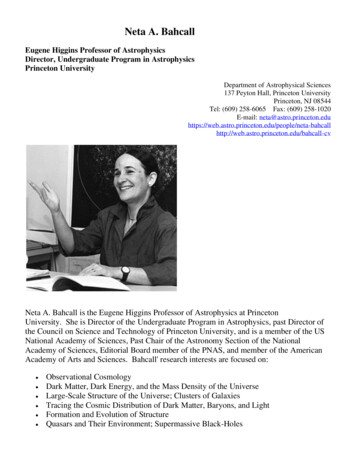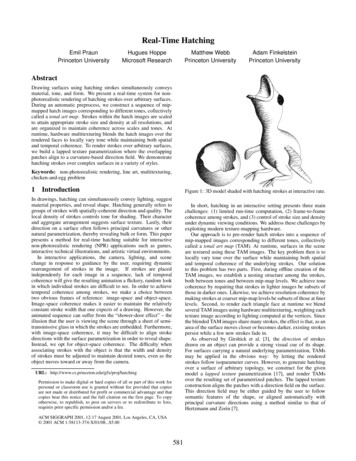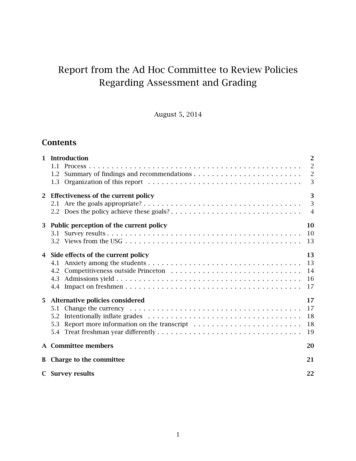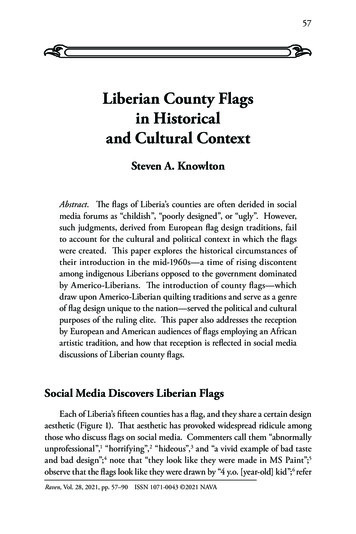
Transcription
Liberian County Flags57Liberian County Flagsin Historicaland Cultural ContextSteven A. KnowltonAbstract. The flags of Liberia’s counties are often derided in socialmedia forums as “childish”, “poorly designed”, or “ugly”. However,such judgments, derived from European flag design traditions, failto account for the cultural and political context in which the flagswere created. This paper explores the historical circumstances oftheir introduction in the mid-1960s—a time of rising discontentamong indigenous Liberians opposed to the government dominatedby Americo-Liberians. The introduction of county flags—whichdraw upon Americo-Liberian quilting traditions and serve as a genreof flag design unique to the nation—served the political and culturalpurposes of the ruling elite. This paper also addresses the receptionby European and American audiences of flags employing an Africanartistic tradition, and how that reception is reflected in social mediadiscussions of Liberian county flags.Social Media Discovers Liberian FlagsEach of Liberia’s fifteen counties has a flag, and they share a certain designaesthetic (Figure 1). That aesthetic has provoked widespread ridicule amongthose who discuss flags on social media. Commenters call them “abnormallyunprofessional”,1 “horrifying”,2 “hideous”,3 and “a vivid example of bad tasteand bad design”;4 note that “they look like they were made in MS Paint”;5observe that the flags look like they were drawn by “4 y.o. [year-old] kid”;6 referRaven, Vol. 28, 2021, pp. 57–90ISSN 1071-0043 2021 NAVA
58Steven A. Knowltonto them as “the gold standard in awful flag design a form of torture”;7 thinkthey “look like they were taken directly off some parent’s refrigerator”;8 anddeclare, “I would like to say they’ve used clip art, but I don’t know where youwould find clip art that bad”.9 Others ask, “Which one do you dislike the most?LRL [laughing really loud]”10 and “can we just take a moment to understandLiberia’s urgent need for good graphic designers I am distraught”.11 Althoughdiscussion of Liberian county flags appears in most social media platforms, itis most common in Facebook and Reddit, where discussion of flags is quitecommon compared to other platforms.While the references to Microsoft Paint and clip art—two rather unsophisticated types of computer graphic software—are bizarre when discussing flagsFigure 1. Liberian stamps showing the county flags. (CaptainCrape post to Redditr/vexillology, reddit.com/r/vexillology/comments/71uto9/liberian county flag stamps )
Liberian County Flags59introduced in the 1960s (and reflect a rather computer-centric view of flag-designthat detaches it from the fabrication of actual textile objects), the consensusamong commentators seems to be that the county flags of Liberia are childishlysimple in their renderings of the objects that serve as their charges. Negativecomments outnumber positive comments roughly tenfold. (Ironically, thoseflags that feature the most naturalistic renderings of their charges—typicallycivic flags with detailed seals—also come in for a fair share of online abuse.)Stylization and Genre in VexillographyCriticism on social media comes from all corners and does not necessarily reflect the opinions of those who are well-versed in vexillology or design.(There is little discussion of Liberian flags in formal vexillological literature.)Nonetheless, those who engage with flags informally on the internet are insome way intersecting with vexillology and it behooves those undertakingmore formal vexillological investigation to consider popular understandingsof flags. As Scot Guenter notes, flag design and aesthetic judgment of flags isa popular practice among flag enthusiasts.12The specific criticisms of Liberian county flags—that they are crudelydrawn or childish—ignores that fact that almost all flags feature stylized images.Rather than carping that the cross of Sweden lacks appropriate woodgrain andnail holes, or that Vietnam’s star is insufficiently scintillated, most flag designcritics accept that symbols are reproduced “through simplification, exaggeration, or idealization” rather than in exacting detail (Figure 2).13 Stylization is“ubiquitous and most likely quite unavoidable” due to the gap between whatis seen and the technology available to reproduce it in an artistic medium;this is all the more true when working in textiles, which are less amenableto detailed depictions than oil paints or lithography.14 The manner in whichstylization is accomplished is one of the markers of a shared culture: audienceswho employ a common visual vocabulary will recognize the salient featuresof an object—typically its silhouette, and the caricature-like inclusion of distinctive attributes—despite their stylization, while “a true grasp of its style byany external group is impossible, because the stylistic character of these objectsis impenetrable to all but the cultural group that originally created” them.15Popular understandings of “good flag design” often elevate flags that arestylized in a way similar to heraldic designs. This European artistic tradi-
60Steven A. KnowltonFigure 2. Top row: the flag of Sweden and a wooden cross; Lower row: the flag ofVietnam and the star Vega. (Sources: freeimages.com ; Ihar, “BBC Cross”, flickr.com/photos/ihar/30611184 ; WINHON Flags & Decoratives Store, aliexpress.com/item/32856734126.html ; Sabri Zain, “Fancy a bit of astronomicalscintillation?”, -astronomicalscintillation.html )tion features stylization of animals, crowns, mountains, and other chargesusing techniques originally developed to paint the shields of armored knights.Another European flag tradition, that of striped flags with or without simpleheraldic-style charges, is also highly favored in social media discussions of flagdesign. (Interestingly, many flags designed in either of these styles could alsoeasily be drawn in Microsoft Paint.) When faced with a vexillological patternthat derives from a different tradition, many outsiders fail to grasp that it isstylization rather than ineffectual artistic rendering.As Željko Heimer observes, one of the aims of vexillology is to identify themeans by which flags serve as collective symbols that both face “inward” byspeaking to members of a group using shared symbolism and face “outward”by presenting the group as a unified body to external observers.16 Stylizationhas an inward-facing aspect to it, as it draws upon shared knowledge of howobjects are transformed in an artistic tradition.Stylization on flags, then, is one way of creating a “genre” of flags. Each“family” of flags—heraldic flags, sigillistic flags, Japanese prefecture flags—can be distinguished in part by the technique of stylization employed in the
Liberian County Flags61design of its flags. Liberian county flags may be seen as their own genre of flags,drawing upon a tradition of textile arts not used in other flag genres: the quilt.As Perry Dane notes, “genres—even successful ones—have a history. Andflags themselves—as political symbols, markers of identity, and carriers ofemotional resonance—also have a history. And all that history might have agood deal to say about a particular genre’s place in flag design.”17 To explicatethe way that quilting traditions, with their own methods of stylization, wereemployed to create the genre of Liberian county flags—and the political andcultural purposes of the creation of that genre—let us begin with some historyof the flags, and the nation they represent.The Historical Context of Liberia’s County FlagsOverview of LiberiaThe flags for nine of Liberia’s counties were first presented on 29 November1965 on the occasion of the 70th birthday of President William V. S. Tubman,as a gift from Tubman to the counties (Figure 3). (There were only nine counties at the time; later flags were adopted as more counties were created.)18 Theflag presentations were preceded by the creation of new counties from areasthat were previously governed as frontier provinces. The complex intersectionFigure 3. A display of Liberian county flags surrounding the national flag.( emansion.gov.lr/images/front/flagsDSC 0456.jpg )
62Steven A. Knowltonof circumstances—a national celebration of the president’s birthday, the creation of new political structures—gives context to the investigation into thepolitical and cultural milieu in which the flags’ designers operated. A briefoverview of the developments of Liberian history leading to 1965 must formthe foundation of the analysis.Liberia is a sparsely populated country that stretches along 550 kilometersof the West African coast, extending about 200 kilometers inland. Althoughits population approaches 5,000,000 today, in the 1960s there were a little over1,000,000 residents.19 Before the 16th century, people speaking languages inthe Kruan family moved westward into the area and settled alongside Melspeaking residents, who had lived there since before 1300.20 Around 1500,Mande-speaking people left the savannas north of Liberia and made homesin the forested areas.21 By the 19th century, 16 ethnic groups lived within thecurrent borders (Figure 4).22Generally speaking, land was owned collectively by the residents of a community, with a focus on subsistence agriculture, although surplus was used fortrade. After Portuguese voyagers first contacted residents of the area in 1461, aFigure 4. Ethnic groups of Liberia. (Liebenow, Liberia: The Quest for Democracy)
Liberian County Flags63system of exchange emerged in which European goods were traded for agricultural products, gold, and slaves. The area became known as the Pepper Coastor the Grain Coast, for the melegueta peppers, also called “grains of paradise”,acquired there. However, there was no European encroachment upon the independence of the peoples living along the Grain Coast or its interior.23The Colonization of Liberia by Free Blacks from the United StatesDuring the early 19th century, the United States was experiencing a changein the way some enslaved people were treated. In many of the northern states,gradual abolition of slavery took place during the late 18th and early 19th century, resulting in a growing population of people called “free blacks”. Whileno longer enslaved, free blacks did not enjoy equal rights with white people;for example, they could not vote and were limited in the occupations they wereable to pursue. A number of prominent white leaders were concerned that thepresence of free blacks would destabilize the slave society of the United States,as their example would discourage enslaved black people from accepting theirfate, and would blur the “color line” that required black people to be enslavedand white people to be free. There was also concern that free blacks wouldorganize mass risings of enslaved people against their captors.24An idea that was frequently voiced throughout the period was that freeblacks should leave the United States, perhaps to go to Africa or to Haiti. Whilethis idea was resisted by most free blacks, it gained credence among influentialwhite leaders. In 1816, the American Colonization Society (ACS) was formedfor the purpose of encouraging free blacks to move to Africa. With the cooperation of President James Monroe, in 1821 a U.S. Navy officer named RobertStockton acquired territory on the Grain Coast by threatening a local leaderwith execution, and the ACS became the administrator of a “colony” for freeblacks.25 Despite the general unpopularity of colonization among the free blackpopulation, there were some people willing to risk the venture, and in 1822the ship Elizabeth sailed into the harbor at Cape Mesurado bearing 88 freeblacks, the first Americans to make their homes in the region. The colony wasnamed Liberia, from the Latin liber, meaning “free”, and the capital namedMonrovia, in recognition of the support the ACS had received from Monroe.26The American settlers were not necessarily welcomed by the indigenousinhabitants of Liberia, and a number of military conflicts ensued. Nonetheless, over the next three decades immigration from the United States continued and settlements were established at several locations along the coast and
64Steven A. Knowltonthe banks of large rivers. The American towns were under the administrationof the ACS, or the other colonization societies that sponsored them, such asthe Mississippi State Colonization Society. After a series of incidents in whichBritish officers refused to acknowledge the authority of the ACS administrationover the settlements—among other actions, the British would not recognizethe flag of Liberia as that of a sovereign state—expatriate Americans declaredLiberia an independent nation in 1847; around 3,000 citizens were subject tothe newly established constitution.27While the Republic of Liberia was a unitary, not federal, state, its countieswere an important part of its politics. The original constitution called for legislative representation to be apportioned among the three original counties ofMontserrado, Grand Bassa, and Sinoe.28 Each county comprised settlementsthat had been founded by separate colonization societies, and communicationbetween them was limited because there were no roads.29 Because of their isolation from one another and the capital, each county enjoyed a fair measure ofself-governance.30 They raised taxes internally and created budgets and publicworks projects independently.31 Maryland County was another former colonythat was annexed in 1857, and Grand Cape Mount County was created in 1924from territory acquired by the Liberian government in 1849.32Cultural and Political Clashes between Americo-Liberiansand Indigenous LiberiansFrom the beginning of the republic, the Americans and their descendants(who became known as Americo-Liberians) built a society which privilegedtheir own status against the descendants of Liberians who had been living inthe country before 1821. Although at first the jurisdiction of the governmentextended only to the few coastal towns occupied by Americo-Liberians, withina short time indigenous Liberians came to live in the towns, and a caste systemdeveloped. The uppermost class was Americo-Liberians holding governmentoffice, who often had lighter skin than other Liberians; they were followed bydarker-skinned Americo-Liberians working as farmers and laborers; third werethe “Recaptives” or “Congos”, enslaved Africans from other parts of the continent who had been on ships bound for the Americas that were intercepted bythe U.S. Navy and brought to Liberia; and lowest were indigenous Liberians.33The society dominated by the Americo-Liberians was strongly orientedtoward American customs and values. American fashions, including waistcoats and tailcoats unsuited for tropical weather, were de rigueur for officials
Liberian County Flags65Figure 5. Monrovia in 1825; the flags are difficult to discern but likely appeared asin Figure 6. (The African Repository and Colonial Journal 1, no. 4 (June 1825):129, reproduced at loc.gov/exhibits/african/images/montsera.jpg )and leading merchants; fellowship in Protestant churches was very common;English was the language of government and trade; and the iconography ofthe new republic emphasized both ties to the United States and the notion ofa country founded for free blacks.Americo-Liberian IconographyThe flag adopted for Liberia when under the administration of the ACSwas identical to the U.S. flag, except the canton bore a white cross rather thanstars (Figures 5 & 6).34 In anticipation of independence in 1847, GovernorJoseph Jenkins Roberts (later the first president) assembled a committee of sevenFigure 6. The seal of Liberia,flanked by its pre- and postindependence flags. (TravelSketches from Liberia)Figure 7. The flag of independent Liberia, shownat an Independence Day celebration, late 19thor early 20th century. ( iety-liberia )
66Steven A. Knowltonwomen to design a new flag, because the former flag was “not comprehensiveenough in its significance of the things that we stand for here in Africa.”35The committee’s design included eleven stripes of red and white, and a bluecanton with a single white star. Later government publications attributed thenickname “The Lone Star” to the flag, with the blue canton representing thecontinent of Africa and the star indicating that Liberia was the first republictherein. The stripes correspond to the number of signers of the declarationof independence, and the three colors symbolize the three counties originallyconstituting the nation (Figures 6 and 7).36The national anthem has a similar Americo-Liberian emphasis, includinglyrics such as “We’ll shout the freedom of a race benighted.”37 The seal, alsoadopted in 1847, depicts the ship Elizabeth that brought the first AmericoLiberians, American-style agricultural implements, a dove (symbol of peace),a palm tree, and the motto, “Love of Liberty Brought Us Here” (Figure 6).38The interpretation given to the seal emphasizes such Americo-Liberian notionsas “the fact that through peace prevailing in the country we shall disseminateknowledge among all its inhabitants” and “the sun just emerging symbolizesthe rising or coming into existence of the new Republic”.39Another important cultural marker for Americo-Liberians was the celebration of Matilda Newport Day. This holiday commemorated an occasionin 1822 when the first group of Americo-Liberians came under attack fromindigenous people who wished to resist the Americos’ encroachment on landclaimed through gunboat diplomacy. The legend of Matilda Newport says thatNewport, who would later be a member of the committee that designed thenational flag, saved the fort when, after all the artillerymen had been killed, shelit a cannon with coals from her pipe and drove away the advancing indigenoussoldiers. The celebrations of Matilda Newport were characterized by rhetoricchampioning the cause of “civilization” against “hostile” indigenous people.40Expanding Control over Indigenous Peoples by Americo-LiberiansThrough continued migration from the United States—eventually, thefinal tally of Americans who moved to Liberia was around 15,000—and naturalpopulation growth, the Americo-Liberians came to number around 150,000today.41 In parallel with French and British movements to control the interior of their neighboring colonies of French Guinea, Côte d’Ivoire, and SierraLeone, the Liberian government gradually expanded the area it controlled,through the use of military force and commercial ties that linked the people
Liberian County Flags67of the hinterland to the merchants and officials on the coast. By establishingsovereignty over inland territory, the Liberian government could control theextraction of natural resources and trade, impose taxes and forced labor, andexclude Europeans who wished to enter the same markets.42By the 1920s, the Liberian government held effective control over the entiretyof its current territory. Such control was achieved, in part, by measures thatbroke down traditional governance at the village level, and instead imposed“indirect rule” similar to that seen in British colonies. “Indirect rule” saw thecentral government appointing leaders of an ethnic group who then oversawthe administration of the territory in accordance with the dictates of Monrovia;the result was “the amalgamation of clans into chiefdoms” whose chiefs were“elected” in a manner that was susceptible to manipulation by Monrovia.43Liberian troops were frequently used to exert control over areas that had beenaccustomed to self-rule. This state of affairs allowed the Liberian governmentto impose radical changes to the economic and social life of indigenous Liberians, such as the abolition of domestic slavery in 1930 and the concession in1926 of a gigantic tract of land for the Firestone Tire and Rubber Companyto grow rubber trees.44The domestic slavery, often referred to as “pawning”, was a long-standingsystem in which people unable to pay their debts would indenture themselvesor a relative for a limited period.45 Because Americo-Liberian rule had weakened the traditional authority of indigenous leaders who guaranteed againstabuse of indenture, a system of forced labor came about; government officialsworked with those who held the indentured people in bondage to sell theenslaved people’s labor on plantations within Liberia and in other parts ofAfrica, notably the Spanish colony of Fernando Pó (now Bioko, part of Equatorial Guinea). Although a League of Nations inquiry led to the resignation ofPresident Charles King in 1930, the export of labor continued through at least1935, and forced labor was used on the Firestone plantation as late as 1965.46While the indigenous people of the hinterland were under the rule of theLiberian government, they were not full members of the body politic. Theycould not vote, and the territory they occupied was not represented in theLiberian legislature. There was no independent judiciary.47 Instead of havingcounties, the interior of the nation, “inhabited by uncivilized Liberians”, wasdivided into provinces whose administrators were appointed by the presidentof Liberia.48 Resentment in the frontier provinces toward the Liberian centralauthorities was widely expressed through means such as refusal to pay taxes
68Steven A. Knowltonand even armed resistance, and the notoriously violent and corrupt LiberianFrontier Force frequently resorted to deadly measures to quell unrest.49The “Unification Policy” of William V. S. TubmanIn 1944, a new president took office determined to better integrate the frontier provinces and their people into the Americo-dominated Liberian nation.William V. S. Tubman was, himself, something of an outsider in the insularworld of Liberian politics, as he hailed fromthe easternmost county, Maryland, and hadbuilt his network of supporters in a rural areawhere Americos and indigenous people interacted more freely than they did in the capital(Figure 8).50 Tubman was re-elected every fouryears until his death in 1971, and his administration is widely seen as a transformative erain the nation’s history. Among his initiativeswere expanded economic ties between Liberiaand the developed nations of Europe and theFigure 8. President WilliamAmericas that increased the standard of livingVacanarat Shadrach Tubmanfor many Liberians (an aspect of which was(served 1944–71). (flickr/the first use of the Liberian national flag as aELCA Archives)“flag of convenience” for multinational shippers who register their ships in Liberia to take advantage of its relatively laxmaritime code).51 He also elevated the presidency to a quasi-monarchical roleand urged a policy of “unification”. The latter two aspects of his administration are most relevant to the discussion of county flags.Through his policies, and through personal gestures such as travelling toremote areas of the country to hear the concerns of Liberians living outsideMonrovia, Tubman engendered a great deal of genuine admiration and affection from his compatriots.52 Using the power of patronage, he cultivated clientswho supported him in return for access to government funds and Americanmarkets.53 He also gradually put into place a system of secret police and spiesthat reported any dissent from the Tubman line, with dire consequences tothose perceived as disloyal.54 By the 1960s, a cult of personality had developedaround Tubman, and his birthday was celebrated as a national holiday andextravagant gifts such as airplanes and yachts were “donated” to the presidentby the “grateful” residents of a different county each year. His name or thoseof his family members came to grace many a public facility.55
Liberian County Flags69Tubman’s “Unification Policy” was intended to bring the indigenous peopleof Liberia more fully into the society ruled over by Tubman. Full citizenshipwas granted to all Liberians in 1947.56 Roads, schools, health care facilities,and communications were extended into the hinterland provinces, and administration of justice was made more transparent.57 Of note, though, is that theUnification Policy did not have the effect of giving the indigenous peoples ofLiberia a greater voice in its governance, but rather of bringing more Liberiansunder the sway of the national government organized along Americo-Liberianprinciples. For example, the greater provision of government services to thehinterland actually extended the reach of Monrovia into the countryside. Similarly, schools that were erected in the rural areas had a curriculum oriented toAmerico-Liberian history and ideals.58Tubman made gestures toward acknowledging the value of indigenous cultures, such as occasionally wearing traditional dress during visits to the interiorand establishing an African cultural center to preserve the arts of indigenouspeoples.59 Liberians were encouraged to discontinue speaking in terms of “uncivilized brethren” or “country people” or even “Americo-Liberians” but rather toembrace “social pluralism” that encompassed Liberians of all backgrounds.60At the same time, Tubman insisted on retaining the symbolic dominance ofAmerico-Liberian iconography, by dismissing calls to change the seal, motto, orflag of Liberia, and retaining holidays such as Pioneers Day and Matilda Newport Day that celebrated the triumph of Americo-Liberian culture over indigenous resistance, by noting that “if the defenders of the Commonwealth hadlost the day in the Battle of the Fort Hill there would have been no Liberia.”61In fact, during this period patriotic exercises such as flag-raising and singingthe national anthem and other patriotic songs were mandated at the nation’suniversities and colleges as well as at public schools.62 Despite this indoctrination, some indigenous Liberians resented the Americo-Liberian dominance ofnational symbols. One common retort to the national motto (“Love of LibertyBrought Us Here”) was “The Love of Liberty Met Us Here”.63The most dramatic event related to the Unification Policy was the creationin 1964 of four new counties from the hinterland provinces (Figure 9). Lofa,Bong, Nimba, and Grand Gedeh counties became the constitutional equalsof the five coastal counties, with rights to elect members of the national legislature and the same local government structures as the rest of the country. Inaddition to the advertised effects of greater integration of indigenous Liberiansinto the body politic, the erection of a civil service bureaucracy in each of thenew counties also provided Tubman more opportunities to offer patronage.64
70Steven A. KnowltonFigure 9. Administrative divisions of Liberia, before and after the creation of newcounties in 1964. (Liebenow, Liberia: The Quest for Democracy)Just over a year later, the flags of the nine counties of Liberia were unfurledfor the first time. But the establishment of the flags was not directly in responseto the creation of the new counties; in fact, they had a long gestation period.The Development of County FlagsThe idea for county flags was first broached by Tubman in his annualaddress to the legislature of 1961. Reflecting on what he deemed successfulefforts at national unification to date, he said, “Fortunately we have endeavoured to instill national consciousness into the hearts of the people of the country. We must now take measures to nourish this national cohesiveness by theintroduction of another element in our political annals—the use of territorialand county flags to foster a deeper county and territorial spirit. It is thereforerecommended that you authorize the design of a county or territorial flag foreach county and territory within the Republic.”65This rhetoric, with its emphasis on fostering loyalty to local governmentrather than ethnic groups or villages, underlines one of the purposes of theUnification Policy—to reorient indigenous power structures in ways that better served the Tubman administration. A spirit of county pride would alignpersonal identity with the formal structure of power through which Tubman’spatronage flowed.
Liberian County Flags71The legislature, by then a rubber stamp for Tubman’s initiatives, on 11 April1962 passed An Act to Authorize the President of Liberia to Set Up Committeesin the Respective Counties and Territories to Design County and TerritorialFlags for Each County and Territory within the Republic, which stated that,Whereas, the people of Liberia have shown a deep spirit of Nationalconsciousness, and in order to nourish our National cohesiveness, it isconducive to introduce another dimension in our political annals; andWhereas, the use of County and Territorial flags would foster adeeper County and Territorial spirit; Now Therefore The President is hereby authorized to appoint Committees forthe purpose of designing a County or Territorial flag for each Countyand Territory within the Republic . Each Committee after completing a design of the flag, shall make its report to the President forsubmission to the Legislature.66At some point between 1962 and 1965, the committees must have reportedto President Tubman, and his office approved the designs as we know them.However, no legislative action finalizing the flag design process was recordedin the nation’s law code.Given Tubman’s grip on the civil affairs of Liberia, it is questionable howmuch say the committees truly had over the designs of the county flags. To besure, some intervention came between the committees and the final design, asa template was imposed that placed “a miniature Liberian flag in the upper leftcorner to indicate that [the county] is an integral part of the nation.”67 Thereis also a similarity in design that one might credit to a single artistic vision.(The placement of national flag in the canton of a sub-national or colonialflag is a practice with its roots in the Bri
There was also concern that free blacks would organize mass risings of enslaved people against their captors. 24 An idea that was frequently voiced throughout the period was that free blacks should leave the United States, perhaps to go to Africa or to Haiti. While this idea was resisted by most free blacks, it gained credence among influential
